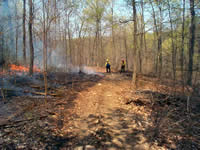Prescribed Burning Promotes Growth of Buffalo Clover
 Close-up view of buffalo clover (Trifolium reflexum) plants on the Hoosier National Forest in Indiana at the Boone Creek Special Area. Photo by Kirk W. Larson, US Forest Service.
Close-up view of buffalo clover (Trifolium reflexum) plants on the Hoosier National Forest in Indiana at the Boone Creek Special Area. Photo by Kirk W. Larson, US Forest Service.
 Scattered plants of buffalo clover (Trifolium reflexum) growing interspersed with other dry forest and barrens vegetation. Photo by Kirk W. Larson, US Forest Service.
Scattered plants of buffalo clover (Trifolium reflexum) growing interspersed with other dry forest and barrens vegetation. Photo by Kirk W. Larson, US Forest Service.
 Forest Service personnel are shown shortly after the first ignition of the prescribed burning project to restore barrens communities in the Boone Creek Special Area on the Hoosier National Forest in Indiana. Photo by Teena Ligman, US Forest Service.
Forest Service personnel are shown shortly after the first ignition of the prescribed burning project to restore barrens communities in the Boone Creek Special Area on the Hoosier National Forest in Indiana. Photo by Teena Ligman, US Forest Service.
Buffalo clover (Trifolium reflexum) is listed as endangered by the state of Indiana. This rare plant was discovered on a Hoosier National Forest special area in May of 2007 following a prescribed burn in south-central Indiana. The plants occur in an open canopy of dry oak forest immediately adjacent to a barrens plant community in the Boone Creek Special Area. This population is the only known occurrence of buffalo clover on the Hoosier National Forest and just the second extant population known to occur in Indiana. In Indiana, buffalo clover has fewer existing populations than running buffalo clover (Trifolium stoloniferum), which is listed as endangered under the federal Endangered Species Act.
Apparently, the recent discovery of buffalo clover is due to the repeated prescribed burning of the area that stimulated germination of its pre-existing seed bank. Similar results have occurred for the species in other locations in nearby states, including the Shawnee National Forest in southern Illinois. Buffalo clover most often occurs in areas associated with natural or human-caused disturbance. Botanists hypothesize that fire, formerly set by Native American Indians, promoted the continued existence of buffalo clover and running buffalo clover. Many legumes, such as buffalo clover, benefit from fire scarification of their seed. Fire not only stimulates germination of pre-existing buffalo clover seed but also creates an appropriate seedbed for successful seedling establishment.
Since the early 1990s, the Hoosier National Forest has increased management efforts to restore the barrens natural communities and adjacent oak woodlands and forests of the Boone Creek Special Area by periodically applying prescribed fire to this fire-dependent landscape. The Hoosier National Forest also restores and manages other barrens communities on the forest. Barrens are globally rare natural communities that often contain spectacular displays of wildflowers and grasses more often seen in a prairie setting. Barrens occur within areas of hardwood forest because of certain geological and soil conditions, slope aspect, and disturbance regimes that do not support tree growth. Historically, frequent fires played an important role in the maintenance of these prairie-like inclusions. Biologists believe that the greatest threat to barrens ecosystems is encroachment of woody plants due to the interruption of a periodic fire regime that historically was placed on the landscape by Native Americans for a number of cultural reasons. With the advent of European settlement, the use of fire declined to the point where, all fires have been systematically suppressed. This change on the landscape allowed barrens to change into oak woodlands and forests over time.
Results from these restoration projects have shown a dramatic expansion of warm season grasses and prairie forbs, and other fire-dependent plants. Many species not previously observed in these barrens are being discovered. Prior to the discovery of buffalo clover, botanists discovered a new population of prairie parsley (Polytaenia nuttallii), another Indiana state endangered species, in the barrens after conducting the first prescribed burn on the site in the early 1990s.
For More Information
Kirk W. Larson, Forest Botanist US Forest Service Hoosier National Forest Bedford, Indiana 812-275-5987

